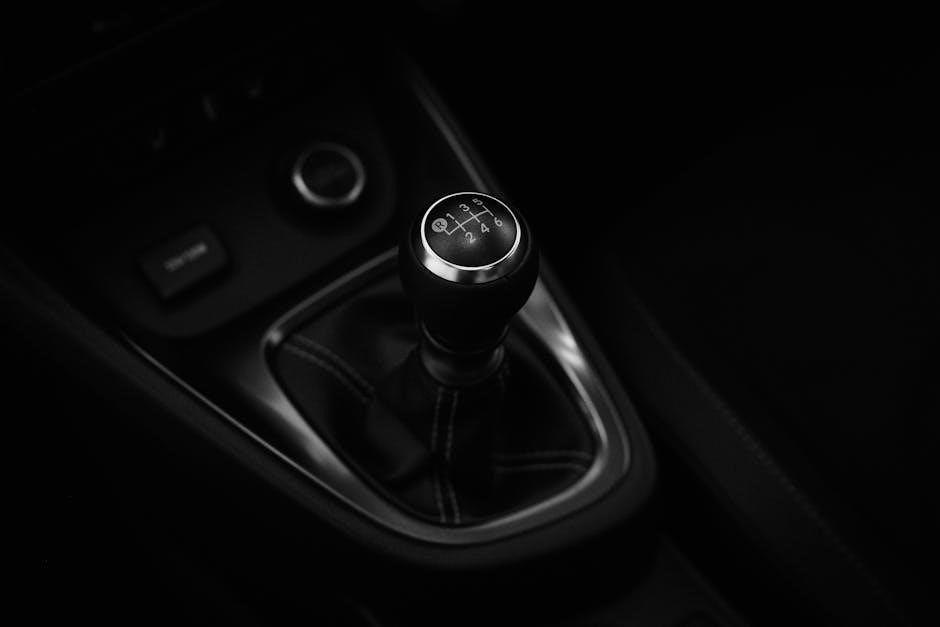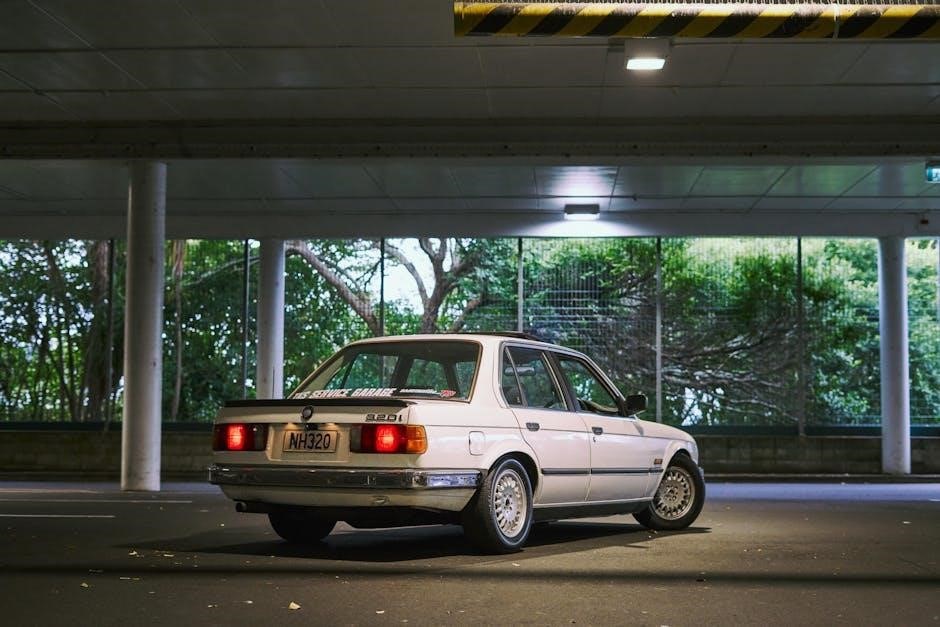The 1UZ-FE, a powerful V8 engine, was never factory-equipped with a manual transmission, sparking enthusiast interest in conversions. Popular options include the W58 and R154 transmissions, while some explore BMW or Audi gearboxes for unique setups.
Overview of the 1UZ-FE Engine
The 1UZ-FE is a 4.0-liter, quad-camshaft, 32-valve V8 engine produced by Toyota, renowned for its smooth operation and reliability. Designed for luxury vehicles like the Lexus LS400, it features a lightweight aluminum alloy block and cylinder heads, enhancing power-to-weight efficiency. The engine incorporates variable valve timing, optimizing performance across a wide RPM range. Its naturally aspirated design ensures durability and low maintenance, making it a popular choice for enthusiasts. Known for its refined power delivery and minimal vibration, the 1UZ-FE has become a favorite for engine swaps and custom builds, particularly for those seeking a balance of power and sophistication.
Importance of Manual Transmission Conversion
Converting the 1UZ-FE to a manual transmission enhances driving engagement and control, offering a more immersive experience. This swap is particularly appealing to enthusiasts seeking improved performance and precision. Manual transmissions provide better fuel efficiency and cost-effectiveness compared to automatics. Additionally, a manual setup reduces weight and eliminates reliance on torque converters, enhancing acceleration. For racing or spirited driving, manual transmissions are preferred due to quicker gear changes and improved reliability under high-stress conditions. The conversion also allows drivers to fully utilize the engine’s power band, making it a popular modification for those aiming to optimize performance and driving dynamics.

Background and History
The 1UZ-FE, a 4.0L V8 engine, was produced by Toyota from 1989 to 2009, primarily paired with automatic transmissions. Its lack of factory manual options led enthusiasts to explore swaps like the W58 and R154, fostering a community-driven movement for performance and customization.
Factory Transmission Options for 1UZ-FE
The 1UZ-FE engine was never offered with a factory manual transmission, as Toyota exclusively paired it with automatic transmissions like the A340E, A341E, and others. This lack of a manual option from the factory has driven enthusiasts to explore aftermarket solutions, including adapters and custom setups, to achieve a manual transmission configuration. The absence of a factory manual transmission has also led to a thriving community of modifiers and fabricators, creating a wide range of options for those seeking to convert their 1UZ-FE to a manual setup.
Popularity of Manual Swaps in the Automotive Community
Manual transmission swaps for the 1UZ-FE engine have gained significant popularity among automotive enthusiasts, driven by the desire for better control, performance, and a more engaging driving experience. The lack of a factory manual option has inspired creativity, with many turning to aftermarket solutions and custom fabrications. This trend has fostered a thriving community of modifiers and builders who share knowledge, parts, and expertise. The 1UZ-FE’s power and smoothness make it an attractive candidate for manual conversions, despite the challenges involved. As a result, the popularity of these swaps continues to grow, fueled by the passion for unique and tailored setups.

Evaluating Transmission Options
Evaluating manual transmission options for the 1UZ-FE involves assessing compatibility, strength, and cost. Popular choices include the W58 and R154, while less common options like BMW or Audi gearboxes may require custom fabrication.
W58 Transmission: Features and Compatibility
The W58 transmission is a popular choice for 1UZ-FE manual conversions due to its durability and strength. Originally designed for Toyota’s Supra, it offers a robust 5-speed manual setup with a strong gear set. The W58 is known for its reliability under high horsepower and torque, making it suitable for the 1UZ-FE’s V8 power. However, compatibility requires an adapter plate and bellhousing fabrication, as the W58 wasn’t factory-mated to this engine. Additionally, the shifter and linkage may need modifications to fit the new setup. Despite these fabrication needs, the W58 remains a top option for enthusiasts seeking a reliable manual transmission solution.
R154 Transmission: Advantages and Considerations
The R154 transmission is a 5-speed manual gearbox that offers robust strength and compatibility with the 1UZ-FE engine’s torque output. Known for its durability, the R154 is a popular choice among enthusiasts for its smooth shifting and reliability under high-performance conditions. However, adapting it to the 1UZ-FE requires an adapter plate and custom bellhousing, as it wasn’t originally designed for this engine. This adds complexity and cost to the conversion process. Despite these challenges, the R154’s modern design and strong internals make it a viable option for those seeking a reliable manual transmission setup for their V8-powered projects.
Other Manual Transmission Options (e.g., BMW Getrag, Audi 012)
Beyond the W58 and R154, enthusiasts exploring manual transmissions for the 1UZ-FE can consider alternatives like the BMW Getrag or Audi 012. The BMW Getrag gearbox is noted for its affordability and strength, making it a cost-effective option. Audi’s 012 transmission, while less common, offers a unique setup that can be adapted with custom fabrication. These options provide diversity, allowing builders to tailor the drivetrain to specific performance goals. However, they often require extensive modifications, including custom adapter plates and engineering, which can increase both time and budget. These transmissions appeal to those seeking a distinct, non-traditional setup for their V8 engine.

Planning the Swap
Planning the swap requires careful consideration of parts, wiring, and ECU modifications. Budgeting for custom components and allocating sufficient time for fabrication and installation is essential for success.
Parts and Components Needed
A manual transmission swap for the 1UZ-FE requires specific components, including an adapter plate, bellhousing, clutch kit, and compatible transmission like the W58 or R154. A custom flywheel must be fabricated to mate the engine with the transmission. The clutch master and slave cylinders, along with the pedal assembly, are essential for proper clutch operation. Additional modifications may involve wiring harness adjustments and ECU reprogramming to accommodate the manual setup. While some parts are available off-the-shelf, others may need custom fabrication, emphasizing the importance of thorough planning and research before starting the project.
Wiring and ECU Considerations
The 1UZ-FE engine’s wiring harness requires modifications to accommodate a manual transmission, as it was originally designed for an automatic. Key wires controlling functions like the reverse light and clutch switch must be spliced. The ECU, configured for automatic operation, may need reprogramming or replacement with a standalone unit to eliminate CEL issues. Additionally, the throttle-by-wire system, if present, must be recalibrated for manual shifting compatibility. Proper wiring and ECU adjustments are critical to ensure smooth operation and prevent error codes, making this step challenging but essential for a successful manual swap.
Budget and Time Requirements
Converting the 1UZ-FE to a manual transmission requires a significant budget, as custom parts like adapter plates, clutch kits, and transmission components can be costly. Labor costs may also add up, especially if professional fabrication or wiring work is needed. The timeframe for completion depends on the individual’s mechanical skills and availability, but expect several weeks to months for a thorough swap. Detailed planning and sourcing parts in advance can help mitigate costs and delays. While challenging, the end result is a unique and rewarding driving experience for enthusiasts willing to invest the time and resources.
Transmission Installation
Installing a manual transmission involves precise alignment and mounting to the engine, ensuring proper connection and secure fastening. Initial adjustments are crucial for smooth operation.
Adapter Plate and Bellhousing Fabrication
Fabricating an adapter plate and bellhousing is critical for mating the 1UZ-FE engine to a manual transmission. Custom machining ensures proper alignment and strength. Materials like steel or aluminum are commonly used for durability. The adapter plate must precisely match the engine’s bellhousing pattern to the transmission’s mounting points. Additionally, the bellhousing may need modification to accommodate the manual transmission’s input shaft and clutch assembly. Professional fabrication or aftermarket kits can simplify the process. Proper fitment ensures smooth power delivery and prevents mechanical failure. This step is essential for a reliable and efficient manual transmission conversion.
Clutch Pedal and Master Cylinder Installation
Installing a clutch pedal and master cylinder is essential for manual transmission operation. The stock SC300 setup is often used, requiring custom drilling and fabrication to fit the chassis. The master cylinder must align with the clutch slave cylinder for proper hydraulic connection. Ensure the pedal assembly is securely mounted and ergonomically positioned for driver comfort. Hydraulic lines must be routed correctly, and the system bled to eliminate air bubbles. Proper installation guarantees smooth clutch engagement and disengagement, critical for reliable performance. Attention to detail ensures consistent pedal feel and prevents mechanical failure during operation.
Mounting the Transmission to the Engine
Mounting the transmission to the 1UZ-FE engine requires a custom adapter plate, as the engine was never factory-equipped with a manual transmission. The adapter plate must align the transmission’s input shaft with the engine’s crankshaft, ensuring proper engagement. Popular options include the W58, R154, or BMW Getrag transmissions, each requiring specific adapter designs. Precise measurements and alignment are critical to avoid damage or vibration. High-strength hardware and proper torque specifications are essential for a secure connection. While some enthusiasts fabricate their own adapters, off-the-shelf kits are available for common transmission setups, simplifying the process and ensuring reliability.

Key Modifications and Fabrications
Custom adapter plates and bellhousings are essential for mating the transmission to the 1UZ-FE engine, ensuring proper alignment and fitment. Drilling the chassis for transmission mounts and modifying the flywheel to accommodate the manual setup are critical steps. Additional modifications may include shifter linkage adjustments and custom fabrication of mounting brackets to ensure seamless integration.
Drilling and Modifying the Chassis
Drilling and modifying the chassis is a critical step in the manual transmission conversion process for the 1UZ-FE engine. The transmission tunnel often requires enlargement to accommodate the manual gearbox, and new mounting points must be created for the transmission crossmember. This ensures proper alignment and stability. Additional modifications may include reinforcing the chassis to handle the added stress of a manual setup. Precision is key, as improper drilling or fabrication can lead to alignment issues or structural weakness. Professional expertise is highly recommended for these modifications to ensure reliability and safety. Proper testing post-modification is essential to verify chassis integrity.
Custom Flywheel and Ring Gear Modifications
Custom flywheel and ring gear modifications are essential for a successful manual transmission swap on the 1UZ-FE. The factory automatic transmission setup requires fabrication of a custom flywheel to mate with the manual transmission. Machining the flywheel to fit the engine’s crankshaft while ensuring proper ring gear alignment is critical. Modifications may involve resizing the flywheel or re-drilling mounting holes to match the transmission’s specifications. This step ensures smooth engagement and proper starter motor function. Precision machining is vital to avoid vibrations or gear clash, making it highly recommended to work with experienced fabricators or specialists in engine and transmission conversions.
Shifter and Linkage Setup
Setting up the shifter and linkage is crucial for precise gear engagement in a manual transmission swap. For the 1UZ-FE, which originally uses an automatic transmission, installing an aftermarket shifter is necessary. Popular options like the BMW Getrag or Audi 012 transmissions influence shifter setup choices. The shifter must be positioned comfortably inside the car, potentially requiring modifications to the center console or floor pan. Proper alignment of the linkage ensures smooth shifting, preventing damage from misalignment. Choosing between hydraulic or cable-actuated systems involves considering complexity versus simplicity. Compatibility with the specific transmission, such as the W58 or R154, is essential. Consulting transmission specifications or community advice can guide decisions. Additionally, driveshaft length and alignment must be considered to prevent vibrations and wear. Selecting the right gear lever length and shift knob enhances the driving experience. Testing the setup post-installation is vital to ensure smooth gear engagement. Seeking guidance from experienced mechanics or forums can aid in achieving optimal performance. Patience and attention to detail are key to successfully setting up the shifter and linkage for the 1UZ-FE manual transmission swap.

Electrical and Wiring Considerations
Manual transmission swaps for the 1UZ-FE require careful wiring modifications, including splicing the harness and reprogramming the ECU to eliminate CEL lights and ensure proper gear engagement.
Understanding the Wiring Harness
The 1UZ-FE engine’s wiring harness is complex, with over 80 wires, but only about 30 are needed for a manual transmission conversion. Identifying the correct wires for throttle position, crankshaft, and camshaft signals is crucial. The ECU must be reprogrammed to eliminate automatic transmission dependencies, which can trigger the CEL light. A detailed wiring guide, such as the 2014 comprehensive guide, is essential for splicing and connecting the necessary circuits. Proper wiring ensures smooth communication between the engine and transmission, avoiding issues like erratic shifting or engine stalling. This step requires patience and precision to maintain reliability and performance.
Splicing and Reprogramming the ECU
Reprogramming the ECU is essential for a manual transmission swap, as the stock ECU is calibrated for automatic use. This involves removing automatic-specific codes and adapting the engine management system. Many enthusiasts opt for a standalone ECU, like an AEM or Haltech, for better control. However, the stock ECU can also be reprogrammed using tools like ECUtek or TunerStudio. Regardless of the method, careful tuning is needed to prevent CEL lights and error codes. Additionally, splicing the wiring harness to remove automatic transmission sensors and solenoids is required to ensure compatibility with the manual setup. This process demands precision and often professional assistance to achieve seamless engine performance with the new transmission.
CEL Light and Error Codes Management
Converting the 1UZ-FE to a manual transmission often triggers the Check Engine Light (CEL) due to the absence of automatic-specific sensors. Error codes like P1760 (Torque Converter Clutch Solenoid) or P1763 (Transmission Solenoid) are common. To resolve these, reprogramming the ECU is necessary to remove automatic transmission-related codes. Some enthusiasts use standalone ECUs that don’t monitor these parameters, while others splice the wiring harness to eliminate unused circuits. Additionally, error codes can be cleared and disabled using diagnostic tools like Techstream or ECUtek. Proper management ensures the engine runs smoothly without persistent CEL issues, enhancing the overall driving experience with the manual setup.

Clutch System Setup
The clutch system is crucial for smooth manual transmission operation, requiring precise alignment of the clutch pedal, master cylinder, and slave cylinder for optimal performance and control.
Choosing the Right Clutch Kit
Selecting the appropriate clutch kit for a 1UZ-FE manual swap is essential for optimal performance. Consider factors such as horsepower, driving style, and material options like organic, ceramic, or racing compounds. Ensure compatibility with the transmission type, whether it’s a W58, R154, or other aftermarket units. Proper fitment with the custom flywheel and alignment with the crankshaft are critical for smooth operation. Many enthusiasts opt for lightweight, high-performance kits to enhance acceleration and reduce wear. Kits from reputable brands or custom fabricators like CRS or Kennedy Engineering are popular choices, offering reliability and durability for both street and track use.
Installing the Clutch Slave Cylinder
Installing the clutch slave cylinder requires careful attention to ensure proper hydraulic connection and operation. The slave cylinder must be securely mounted near the transmission bellhousing, typically using a custom adapter kit. Align the cylinder with the master cylinder and ensure the hydraulic line is properly connected. Bleeding the system is essential to remove air bubbles and ensure smooth clutch engagement. Many enthusiasts opt for lightweight, high-performance kits to enhance acceleration and reduce wear. Kits from reputable brands or custom fabricators like CRS or Kennedy Engineering are popular choices, offering reliability and durability for both street and track use.
Bleeding the Clutch System
Bleeding the clutch system is crucial for eliminating air bubbles that can cause spongy pedal feel or delayed engagement. Start by ensuring the master and slave cylinders are properly connected and functioning. Use a high-quality brake fluid compatible with your system to avoid contamination. Begin bleeding from the slave cylinder, working towards the master cylinder to ensure all air is purged. Some enthusiasts recommend using a vacuum pump for efficiency, while others prefer the traditional two-person method with a bleeding kit. Proper bleeding ensures precise control over clutch engagement, essential for smooth shifting and optimal performance in a manual transmission setup.

Transmission Testing and Adjustment
Initial startup checks involve verifying smooth gear engagement and clutch operation. Adjustments may be needed for clutch pedal feel and shifter alignment. Testing under load ensures reliability.
Initial Startup and Gear Engagement
After installation, the initial startup involves checking for leaks and ensuring proper fluid levels. Engage the clutch slowly, listening for smooth gear engagement. Partial throttle engagement helps test low-speed operation. Monitor the clutch pedal feel and gear synchronization. Ensure no unusual noises or slipping occur during initial testing. Pay attention to the engine’s response and transmission behavior under light load. This step is critical for identifying any immediate issues before proceeding to more demanding conditions. Proper adjustment of the clutch and shifter linkage is essential for seamless gear transitions. A successful initial startup sets the foundation for reliable performance.
Adjusting the Clutch and Shifter
Proper adjustment of the clutch and shifter is essential for smooth operation. Start by setting the clutch pedal free play to ensure proper engagement. Adjust the master and slave cylinders to eliminate excessive slack or sponginess. Fine-tune the shifter linkage for precise gear alignment, avoiding misalignment that could cause grinding. Test the system under various conditions to ensure consistent performance. Small adjustments can significantly improve drivability; Bleeding the clutch system may be necessary to remove air bubbles affecting pedal feel. Ensure the shifter is securely mounted and aligned for smooth transitions between gears. Proper adjustment ensures optimal performance and longevity of the manual transmission setup.
Testing Under Load and Various Conditions
After initial setup, thoroughly test the manual transmission under load and diverse conditions to ensure reliability. Begin with city driving to assess low-speed maneuverability and smoothness. Gradually progress to highway speeds, monitoring for any slipping or unusual noises. Test inclines and aggressive acceleration to evaluate torque handling and gear engagement. Pay attention to shifting consistency and resistance. Check for any signs of overheating or fluid leaks under heavy load. Adjust driving habits to protect the transmission and ensure proper fluid levels are maintained. This comprehensive testing phase is crucial for identifying and addressing any lingering issues before finalizing the swap.

Potential Issues and Solutions
Common challenges include ECU compatibility, CEL lights, and transmission adapter fitment. Solutions involve precise wiring, custom adapters, and thoroughly testing under various conditions to ensure reliability.
Common Problems During the Swap
Common issues during a 1UZ-FE manual transmission swap include ECU compatibility problems, CEL lights due to the engine computer detecting an automatic transmission, and the need for custom adapter plates. Wiring harness modifications are often required to integrate the manual transmission, and improper clutch system setup can lead to hydraulic leaks or engagement issues. Additionally, drivetrain compatibility must be carefully verified to ensure proper alignment and mounting of the transmission. These challenges highlight the importance of meticulous planning and expertise to avoid costly setbacks and ensure a smooth conversion process.
Troubleshooting the Clutch and Transmission
Common clutch and transmission issues during a 1UZ-FE manual swap include CEL lights due to ECU incompatibility and improper clutch engagement. Hydraulic leaks in the slave cylinder or master cylinder can occur, requiring careful inspection and replacement of seals. Additionally, improper flywheel resurfacing may lead to clutch failure or uneven engagement. Gear grinding or failure to engage can result from incorrect gear ratio selection or misalignment during installation. Troubleshooting involves checking wiring harness modifications, ensuring proper clutch pedal adjustment, and verifying transmission-to-engine alignment. Addressing these issues early ensures smooth operation and prevents costly repairs down the line.
Addressing Wiring and ECU-Related Issues
Manual transmission swaps for the 1UZ-FE often require wiring modifications to adapt the ECU for manual operation. The ECU must be reprogrammed or replaced to eliminate automatic-specific settings. Wiring harness splicing is necessary to integrate manual components like clutch and gear position sensors. CEL issues arise due to incompatible ECU configurations, requiring careful troubleshooting of error codes. Professional services or standalone ECUs are often recommended for seamless integration. Proper wiring and ECU setup ensure smooth operation and prevent drivability issues, making this step critical for a successful manual conversion.

Community and Resources
Online forums and communities provide extensive support for 1UZ-FE manual swaps. Recommended guides and tutorials offer step-by-step instructions, while professional services and kits simplify the conversion process.
Online Forums and Communities
Online forums and communities are invaluable resources for 1UZ-FE manual transmission projects. Platforms like Toyota Nation, Supra Forums, and Reddit’s car modification communities offer detailed threads, guides, and personal experiences. Enthusiasts share insights on transmission swaps, wiring, and fabrication. These forums often include step-by-step tutorials, photos, and videos, providing practical advice for overcoming common challenges. Members frequently discuss transmission options like the W58, R154, and Audi 012, as well as clutch setups and ECU modifications. Additionally, these communities connect builders with experts and vendors, fostering collaboration and innovation. Real-time support and access to proven solutions make online forums indispensable for a successful manual swap.
Recommended Guides and Tutorials
Several comprehensive guides and tutorials are available to assist with the 1UZ-FE manual transmission conversion. A detailed wiring guide specific to EFI engines, including the 1UZ-FE, offers diagrams and instructions for splicing and reprogramming the ECU. This resource is crucial for resolving CEL issues and ensuring proper engine communication with the manual setup. Additionally, CRS provides a complete kit guide, covering components like the flywheel, bellhousing, and clutch system. These resources, combined with community-shared tutorials, provide a clear roadmap for enthusiasts, helping them navigate fabrication and installation challenges effectively while minimizing trial and error.
Professional Services and Kits
Professional services and pre-engineered kits simplify the 1UZ-FE manual transmission conversion. CRS offers a complete kit, including a rebuilt W58 transmission, flywheel, bellhousing, clutch, and slave cylinder, tailored for this swap. Other specialists provide custom adapter plates and bellhousings, eliminating the need for fabrication. These services often include installation guidance and support, reducing the complexity of the project. Additionally, some companies offer wiring harness modifications and ECU reprogramming to resolve CEL issues. These professional solutions cater to enthusiasts seeking a seamless and reliable conversion, ensuring compatibility and performance without extensive trial and error.
Converting the 1UZ-FE to a manual transmission offers unparalleled control and performance. While challenging, the right planning and resources make this swap rewarding for enthusiasts seeking enhanced driving experiences.
Final Thoughts on the Manual Swap
Completing a manual swap on the 1UZ-FE is a rewarding endeavor, offering enhanced driver engagement and performance. While the process is complex, requiring custom fabrication and electrical work, the end result is well worth the effort. Enthusiasts who pursue this swap gain a unique driving experience, combining the power of Toyota’s V8 with the precision of a manual transmission. With proper planning and execution, the 1UZ-FE can be transformed into a driver’s car, delivering both exhilaration and satisfaction on the road or track.
Future Upgrades and Modifications
After successfully swapping to a manual transmission, owners can explore further enhancements. Upgrading the clutch to a high-performance unit or installing a lightweight flywheel can improve responsiveness. Additionally, modifications like engine tuning, exhaust upgrades, or suspension enhancements can unlock the full potential of the 1UZ-FE. For those seeking more power, supercharger or turbocharger kits are viable options. Future modifications could also include upgrading to a stronger transmission, such as the R154, or integrating modern engine management systems for better performance and reliability. These upgrades ensure the 1UZ-FE remains a formidable platform for enthusiasts seeking both power and precision.